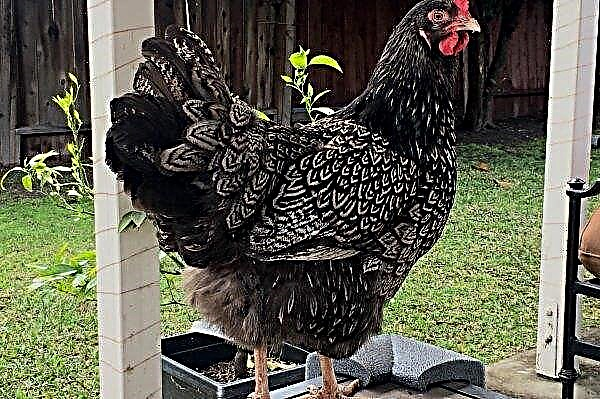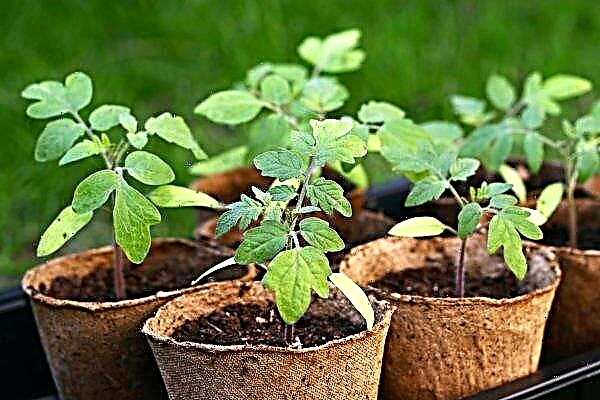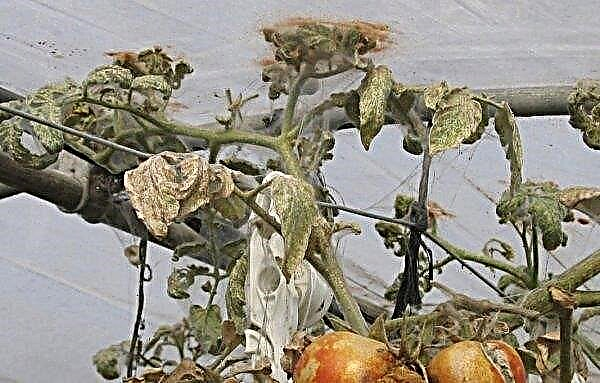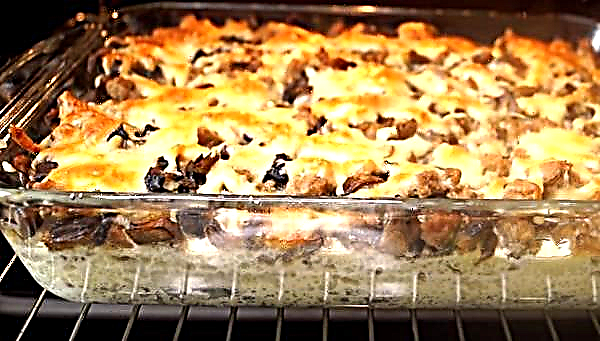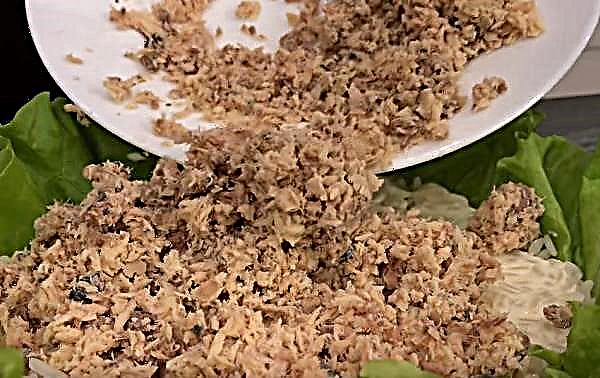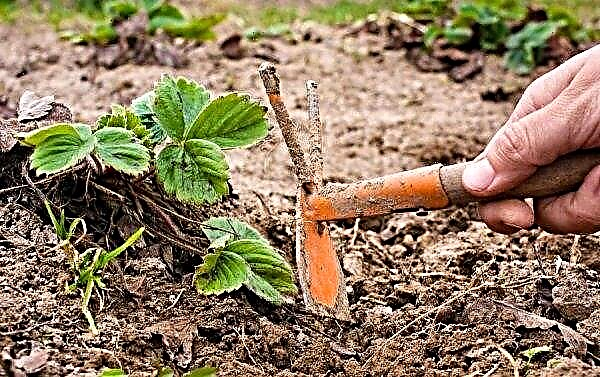Tomato is a southern plant that loves warmth and sun. But, thanks to the efforts of Siberian breeders, in recent years, new tomato varieties have appeared that are resistant to a cool climate and abundantly fruitful even in short summers. These include the Snow Fairytale variety. Below are the main characteristics of the variety and tips on its cultivation.
Grade description
The snow fairy tale was introduced to the State Register in 2006 and recommended for cultivation in Siberia, the Urals and other areas of the risky farming zone. Since that time, tomato has become very popular because it is easy to grow in open ground, and it bears fruit in all weather conditions.
Did you know? In the world there are at least 10 thousand tomato varieties, some of which are very different in size. For example, the smallest tomato looks more like a small berry with a diameter of 2 cm, and the largest one gains a mass of about 1.5 kg.
Main characteristics:
- determinant: grows low (about 50 cm);
- standard: has a powerful stem, but a small root system;
- the bush is compact, densely covered with foliage, has a decorative appearance, the stem is not articulated;
- the inflorescence is simple, the first is tied through 6-7 leaves, and the next - through each leaf;
- due to its compactness and small growth, there is no need for pinching and tying;
- average ripening rate - 105–115 days;
- on each bush up to 30 tomatoes are formed;
- friendly ripening.
 Description of the fruit:
Description of the fruit:- round, red;
- small sizes: 5–7 cm in diameter, weight 60–70 g (maximum 100 g);
- inside 3-4 chambers;
- the skin is dense, the pulp is juicy;
- taste of tomato with sourness;
- universal application, especially suitable for whole-canning.
Advantages and disadvantages
The snow fairy tale fell in love with the Siberian and Ural gardeners for their advantages over other varieties.
- Pros:
- grows equally well in open ground and in a greenhouse;
- tolerates cold and rainy summers;
- guaranteed to bear fruit in any weather;
- brings a high yield;
- suitable for busy people, as It does not require special care;
- beautiful fruits of the same size with excellent taste;
- good germination of seeds collected by hand.
The disadvantages include poor storing and transportability of the fruit.
Do-it-yourself sowing seeds for seedlings
Snow fairy tale, like many other varieties, is grown in seedlings. Of course, you can buy seedlings ready for planting in the ground. But it’s better to grow it yourself from seeds. Good results are shown by seeds collected personally from last year's crop.
Optimal timing
Plant seedlings in the ground in the middle - in the second half of May. At this time, a stable plus temperature is established. So, you can sow seeds throughout March. This is the best time for the seedlings to grow strong enough before planting in a permanent place.
Soil mix
In specialized stores you can buy a substrate for tomatoes. Gardeners with experience believe that it is better to independently prepare the soil to be sure of its quality.
Tomatoes love peaty loose soil.
To prepare it, you need to mix:
- peat - 2 parts;
- garden land (from that part of the garden where tomatoes and other solanaceous trees did not grow) - 1 part;
- sand - 1 part;
- humus or compost - 0.5 parts;
- fertilizers: urea (10 g), superphosphate (30–40 g), potassium salt (10–15 g);
- one of the baking powder: sphagnum, coconut, perlite, vermiculite or sawdust.
 The prepared mixture must be sieved, and then disinfected. The best way to disinfect is to steam the earth in a double boiler. This destroys weed seeds, spores of fungi and dangerous bacteria.
The prepared mixture must be sieved, and then disinfected. The best way to disinfect is to steam the earth in a double boiler. This destroys weed seeds, spores of fungi and dangerous bacteria.Capacity for growing
Seedlings of the Snow Fairy Tale, like other tomatoes, are grown in 2 stages: before the dive and after. Therefore, she needs containers of different sizes: shallow for the first stage, separate containers deeper for the second. The first dishes should be shallow, because small sprouts are comfortable in it.
If the seeds are immediately planted in a deep container and not dive, the roots become tangled, and during transplanting they can be damaged.
The first containers can be:
- wooden or plastic boxes;
- trays and cartridges for seedlings;
- plastic cups (100 g);
- peat tablets.
Important! Whichever container was chosen (except peat tablets), it must be disinfected with a potassium permanganate solution before sowing seeds. This is especially important if it was previously used for growing seedlings..
Tomatoes grow and develop better in individual containers (cups, tablets, trays with a partition). But with the advent of 2 leaves, seedlings still need to dive in a larger container.
Seed preparation
Tomato seeds also need to be prepared for sowing, regardless of whether they are bought or harvested by hand. Preparation includes several actions: some are mandatory, while others depend on the desire of the gardener.
Mandatory training:
- rejection: lower the seeds for 10 minutes in salt water (1 tsp. salt per 1 tbsp of water), the pop-up specimens are rejected, because they are empty, and full-weight washed and dried;
- disinfection: in order to destroy possible bacteria on the surface of the seeds, they are soaked for 20 minutes in a 1% solution of potassium permanganate (pink) or for 7-8 minutes in a warm 2% solution of hydrogen peroxide.
To accelerate seed germination and increase their fertility, many gardeners take additional steps:
- they are soaked for 24 hours in one of the growth stimulants (Epin, Virtan-Micro, potassium or sodium humate) or they use folk nutrients for this, for example, aloe juice or potato juice;
- germinate seeds on a wet gauze at room temperature.

Sowing seeds
The dishes for sowing are filled with soil mixture, after covering the bottom with a layer of drainage. First, the soil is watered with warm water, and when it is absorbed, they begin to plant.
Landing scheme in the general box:
- depth - 1 cm;
- the distance between the grooves is 4 cm;
- step between seeds - 2 cm.
2-3 copies are planted in separate cups, then to choose the strongest. Sown seeds are sprinkled with a thin layer of earth and, if necessary, moistened with a spray. Then the box is covered with a film or glass and put in a warm place until emergence.
Seedling Care
In order for the seedlings to grow strong and normally developed, they need a warm and well-lit place. It could be the windowsill of the south window.
Conditions for normal development:
- temperature: + 22 ... + 25 ° С under the film before emergence and + 17 ... + 18 ° С - after removal of the film;
- lighting for 12 hours, you can use a phytolamp to extend the daylight hours;
- moistening the soil as it dries by spraying it with water at room temperature;
- feeding is not necessary if the soil has been fertilized before sowing;
- diving is necessary when 1-2 leaves appear in separate cups or pots (0.5 l).

Seedling hardening
Hardening is a necessary step that will help tomato seedlings avoid stress when transplanting into open ground and quickly take root.
Seedlings harden:
- 2 weeks before landing at a permanent place;
- taking to the street or an open balcony at an air temperature of + 8 ... + 15 ° С;
- gradually prolonging your stay in the fresh air from 30 minutes to 10 hours.
Planting seedlings in a permanent place
While the seedlings grow on the windowsill and pass hardening on the balcony, you can prepare a plot for it. To do this, you need to make fertilizers, mineral or organic (humus, compost), and dig.
Seedlings are planted in open ground:
- in the middle or end of May, when the frost goes away and the positive temperature is established;
- at the age of 55–65 days, when strong seedlings are ready for transplanting;
- according to the scheme: 60 × 60 cm.
 In cold regions, it is advisable to cover the landing with covering material; you can install a tunnel greenhouse. In the southern regions this is not necessary.
In cold regions, it is advisable to cover the landing with covering material; you can install a tunnel greenhouse. In the southern regions this is not necessary.Outdoor Care
Although the Snow Fairytale is notable for its unpretentiousness, it still needs basic care.
To do this, regularly perform the following actions:
- to water;
- fertilize;
- to loosen and weed;
- protect from pests and diseases.
Watering
Tomatoes love moderation in everything, including watering. They do not tolerate either excess moisture or its lack. Therefore, the best irrigation schedule: when necessary, when the soil dries. In dry times, abundant hydration may be needed once a week, and at other times even less often.
Important! Tomato bushes should be watered so that water does not fall on the leaves and stems. Otherwise, they will contract vertex rot.
It is very important that the bushes receive enough water when the fruits begin to tie up until they ripen. Lack of moisture will result in shedding of ovaries and chopping of the remaining tomato. Acceptable watering methods:
Acceptable watering methods:
- pour water into the furrows dug between the rows;
- water each bush under the root, but carefully so as not to expose the root system;
- drip irrigation (the best).
Top dressing
A snow fairy tale should not be overfed, especially with nitrogen. But you can’t even leave plants without the necessary elements.
Feed rate:
- desired maximum every 2 weeks;
- the required minimum is 3 times (at the beginning of flowering, during fruit set and during ripening).
How to fertilize:
- mineral dressing, consisting of superphosphate (50-60 g), potassium chloride (30-40 g) and ammonium nitrate (15 g) dissolved in a bucket of water;
- organic fertilizer can be a solution of bird droppings or mullein.

Shaping and tying bushes
Bushes of the Snow Fairytale grow low and form a compact and neat crown. Therefore, they do not need pinching, shaping and tying.
But in some cases, gardeners may consider the following actions necessary:
- with very abundant flowering, remove 1-2 buds from each brush so that the remaining ovaries have time to ripen, especially in the conditions of a short summer;
- if many fruits are tied up in the bushes, they tie the branches to vertical trellises or individual supports so that they do not lie on the ground.
But if you mulch the earth with straw, then you can do without a garter and let the fruits ripen, lying on the mulch.
Soil care
Monitoring the condition of the soil in the area with tomatoes is important for their health and abundant fruiting.
Mandatory measures include:
- cultivation is carried out the day after watering or rain, makes the soil water and breathable;
- weeding helps fight weeds, which can be seedlings of bacteria and pests, it is desirable to combine with loosening;
- Mulching keeps moisture in the ground and prevents weeds from growing.
Possible growing difficulties
One of the weak points of the Snow Fairy Tale variety is its susceptibility to diseases and insects by pests. Therefore, preventive measures should not be underestimated.
These include:
- presowing disinfection of seeds, soil and containers for seedlings;
- crop rotation, i.e. Do not plant seedlings in the place where solanaceous plants grew before;
- timely weeding of weeds and harvesting from the bed of plant residues;
- preventive spraying with biological products several times per season (Bactofit, Fitosporin, Pseudobacterin-2 and copper sulfate).
 These actions will protect tomato plantings from infection with fusarium, late blight, mosaic and other bacterial, fungal and viral diseases. Tomato pests include bear, tomato aphid, wireworm, scoop. In the fight against them, special insecticides will help.
These actions will protect tomato plantings from infection with fusarium, late blight, mosaic and other bacterial, fungal and viral diseases. Tomato pests include bear, tomato aphid, wireworm, scoop. In the fight against them, special insecticides will help.Did you know? Tomatoes contain a large amount of serotonin (the hormone of happiness). Therefore, a fresh tomato is a good “pill” from a bad mood.
Tomato Snow Fairy Tale - a wonderful unpretentious variety, great for busy people. It yields high yields in the risky farming zone, and even more so in the southern regions.

